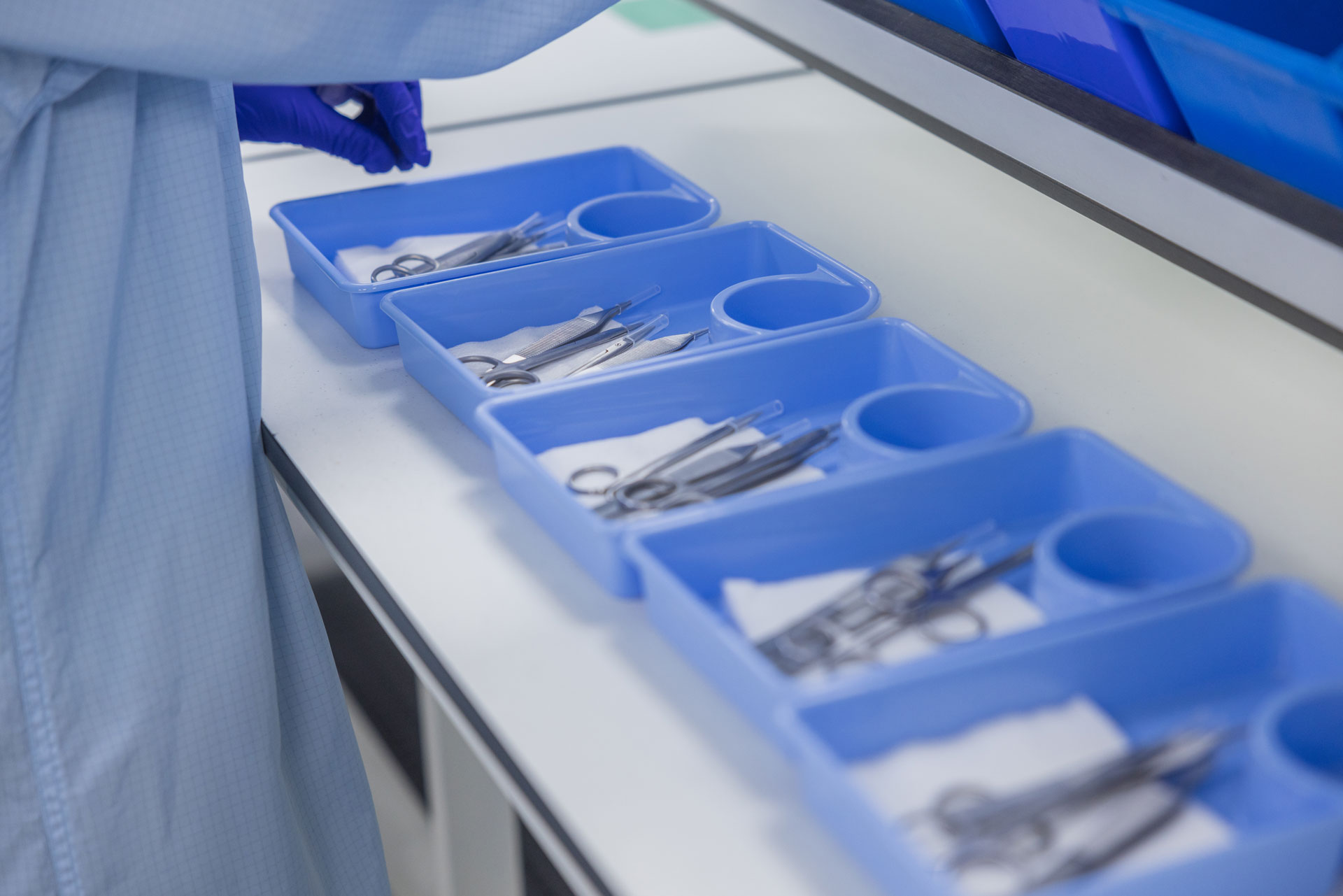Preventing Cleanroom Contamination
When a cleanroom is fully operational, all staff are trained and proper protocols are followed, you can achieve a relatively sterile environment that is suitable for manufacturing medical devices, pharmaceuticals, superconductors and more. However, no facility is perfect, and mistakes are made. This article explores the most frequent types of contaminants that cleanrooms aim to eliminate and the features and procedures that make them effective.
Cleanrooms are only as good as the protocols and procedures you follow when working in them. Whether your facility houses pharmaceutical cleanrooms, low-contaminant spaces for manufacturing medical devices, microchips or medicinal cannabis products, or for conducting laboratory experiments, avoiding contamination is crucial. Dust, bacteria or virus particles in your products or cultures can reduce their quality and effectiveness. Keep on top of cleaning and maintenance to avoid degradation.
The Most Common Sources of Contaminants in Cleanrooms
There are 6 key ways contaminants can enter a space. Remember them easily with the acronym PEARCE: People, Equipment, Airborne, Raw materials, Cross-contamination, and Environmental factors. We’ll describe each one below and how to avoid the contaminants they bring into cleanrooms. This advice is suitable for ISO class 7 or below.
People
The most likely source of contamination in a cleanroom is always the people working inside. You can’t sterilise the human body, so we account for approximately 80% of contaminants that cleanroom inspections pick up.
This isn’t surprising, given that we shed ~1 billion skin cells and 50-100 hairs per day. We also drop clothing fibres and exhale particulate matter (<4μm), such as microbes, outdoor pollutants or particles from cigarette smoke.
Prevention: Strict Gowning Procedures
Surgeons “scrub in” before entering operating theatres to prevent patient contamination, and those who work in any cleanroom also follow strict gowning protocols.
Cleanroom attire may include:
- Cover hair with a hairnet (including beards),
- Cover clothing with a paper boilersuit and shoes with overshoes.
- Avoid wearing clothing that drops a lot of fibres such as a wool jumper.
- Handwashing and gloves.
- Face masks
Which of these are included in your protocol will depend on the classification.
Where gowning is required, your cleanroom design should include a gowning area as an antechamber. This often includes sealed doors, plumbing, sinks, and storage such as lockers and shelving.
Equipment & Tools
Exterior surfaces such as benches, shelving, cupboard fronts, storage boxes, freezers, and biosafety cabinets can gather dust and bacteria. Some materials such as uPVC can build up static on the surface and attract fine particles.
Tools can also harbour bacteria, dust, or rust if not properly maintained.
Contaminants can transfer from these surfaces to mission-critical materials and set your work back.
Prevention: Regular Cleaning & Disinfection
Daily routine cleaning of all exterior surfaces, tools and equipment is important to prevent contamination. Wipe down all surfaces with disposable cloths and disinfectant to destroy microorganisms that may have settled there.

Airborne Particles
Dust, microorganisms, pollen, and mould spores are present in the air in most spaces. Cleanrooms remove these particles and prevent them from entering using sophisticated HVAC systems. The system is a combination of positive air input, pumping filtered air into the room to raise the air pressure slightly, and ventilation fans to pull air out of the room. Usually, these are installed at low levels to create an even flow of clean air from the top down.
The result is a space in which air is regularly changed and airborne particles are pulled down to the floor level and vented. If the system is not maintained, the particle count can rise, either because the filters or the vents have become ineffective.
Prevention: Maintaining Air Filtration & HVAC Systems
Regular air sampling to check the quantity of particulates will highlight any issues with filters or vents. It’s important to install the right kind of filters. Here are the main 3 and their associated replacement frequencies.
Pre-filters sift out large particles from the air before it meets the finer filters. These should be changed 6 times annually.
HEPA (High-Efficiency Particulate Air) filters block particles >0.3μm and are used for ISO 7 or below. Replace HEPA filters once every 4-6 years, depending on your application.
ULPA (Ultra-Low Particulate Air) filters block particles >0.12μm and are used for specialised applications, in cleanrooms classed ISO 5 or below. Replace ULPA filters every 3 years at least, depending on other prefilters.
Cross-contamination
In facilities with multiple cleanroom laboratories, personnel must take care not to transfer matter from one to another. Anterooms for gowning or equipment sterilisation must be maintained carefully to prevent cross-contamination between areas.
For example, leaving doors open between cleanrooms puts strain on air pressure control systems that prevent particulate matter from entering the cleanroom. Cleanroom construction should include multiple doors and antechambers between separate cleanrooms to prevent this.
Prevention: Controlled Airflow & Pressure
Cleanrooms are maintained at a higher air pressure than anterooms to control airflow and maintain cleanliness. The system should hold positive pressure inside the cleanroom, higher than the pressure in the anteroom, which is again higher than the area outside the anteroom. This means that even if both anteroom doors are open, unfiltered air from outside is pushed away from the cleanroom by this pressure cascade. As cleanroom specialists, every design accounts for preventing cross-contamination.
Raw Materials
Incoming products, both exterior packaging and the products themselves could carry contaminants such as dust, microbes, hair or dirt. This should not be allowed to enter the cleanroom directly from delivery.
Prevention: Intake protocol
When accepting deliveries of materials for use inside the cleanroom, an intake protocol will help prevent contamination of the clean area. This protocol may include:
- A designated space to remove and dispose of external packaging (boxes, packing filler)
- Cleaning the exterior of direct packaging (bottles, packets)
- Sample testing chemicals before use to assess purity.
Environmental Factors
Humidity and inadequate airflow can lead to contamination in critical areas. An informed cleanroom design avoids this, as dehumidifiers and HVAC systems are included as needed. However, system failure could lead to rising humidity or a drop in airflow.
Prevention: Monitoring & Compliance
Regularly monitor airborne particle concentration. This can provide early warning of system failures that introduce contamination risks.
- ISO class 5 and below: Test every 6 months
- ISO class 6 and above: Tested at least 1x per year
Once built, we source independent validation and testing of all cleanrooms to ensure they meet our clients’ requirements.
Airology Systems’ Expertise in Contamination Control
Our commitment to quality is evident in every project we undertake – delivering best-in-class solutions for each cleanroom installation.
We provide bespoke low-contamination environments to clients from sectors as diverse as pharmaceutical, medical, veterinary, catering, research, engineering, and technology.
Each bespoke cleanroom is designed and constructed as a complete turnkey solution. We include specialised ventilation, air filtration and environmental control equipment that can meet the required classification.



